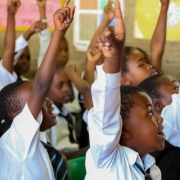Fighting Poverty With Entrepreneurship.
My father, the late Reverend Gilbert H. Caldwell, Jr. was a Civil Rights Movement “foot soldier” who knew and marched with Dr. Martin Luther King, Jr. As a child of the “Movement,” I paid close attention to Dr. King’s strategic approach to transforming the United States. Most people are not aware that the official name of the march where he delivered his famous “I Have a Dream” speech was the “March on Washington for Jobs and Freedom.” In this historic speech, he states that it is tragic that some people live “on an island of poverty in the midst of a vast ocean of material prosperity.” Dr. King knew that racial equality would only be sustainable if residents of poor communities had jobs that enabled them to pay their monthly bills. I am convinced that if he were alive today, Dr.King would say that the economic stability of communities is the foundation of the social well-being of countries.
No country has sufficient funds to fight poverty in perpetuity. Current “top-down” poverty reduction programs providing a “safety net” have had little success reducing systemic poverty. The current safety net programs trap families in a net of economic instability that is difficult to untangle. It is time for a “people up” poverty reduction program designed to provide a “safety trampoline” that bounces people up from poverty to the middle class. Poverty reduction strategies must be based on the belief that if you give someone a fish you can feed them for a day. However, if you help them start a fishing business you can feed a community for a generation.
The United Nations made “Ending poverty in all its forms” its number one Sustainable Development Goal because the inability of people throughout the world to feed, house, clothe and educate their families is a“cancer” on society that can be cured if innovative new approaches are implemented at the community level. The Grameen Bank microfinance program, created by the 2006 Nobel Peace Prize winner Mohammed Yunis, is an example of a successful innovative program that works very well in certain circumstances. Unfortunately, the community development bank approach has limited applicability in many locations. One of the most successful ways to reduce poverty in the Group of Twenty (G20) countries is to implement a place-based program called “Entrepreneur Zones” or “EZones.”
Specific words can be a powerful tool in generating support for a community revitalization program. The term “Entrepreneur” refers to a specific person committed to utilizing novel approaches to creating value. The term “Zone” is a specific location with clear boundaries. Historically, poverty reduction programs have been disconnected “social support” programs that exist as long as there is political support and government funding. The EZones are a“social investment” program designed to help entrepreneurs create jobs and generate greater income and tax revenue. One of the key components of the program is the provision of quality job training and placement for residents. By investing in EZones with public funding, private investment, grant funds, and tax credits, economically challenged communities can generate the revenue and jobs needed to reduce local poverty in a sustainable way (without the need for long-term government funding).
One of the best examples of an Entrepreneur Zone was the Greenwood Section of Tulsa, Oklahoma. Plessy v. Ferguson was a landmark Supreme Court decision in 1896 that upheld the constitutionality of racial segregation in the US. Black communities survived this racist ruling by developing, what we would consider today as, segregated EZones that succeeded economically because of thriving black-owned small businesses. These neighborhoods fought against discrimination by developing healthy communities rooted in entrepreneurship. The wealthiest of these communities was the Greenwood Section of Tulsa. This community was so strong economically that it was nicknamed “Black Wall Street.” White supremacists and the local government were so jealous of the economic success of this community that on June 1, 1921they bombed it by plane and attacked it by foot. Tragically, more than 300 people were killed and 200 businesses destroyed simply because the black community was living the “American Dream” of entrepreneurial success.
One positive lesson that we can learn from this embarrassing American history is that when economically challenged communities are given the opportunity to develop entrepreneurial businesses they can flourish and transform poor communities into middle-class communities. Government leaders committed to implementing sustainable solutions to chronic poverty should establish EZones in economically challenged communities around the world. Businesses in these locations should receive public funding, regulation relief, investment fueled by tax credits, grants, and entrepreneurship training. In addition, qualified nonprofit organizations should provide poverty-informed job training and placement programs helping the long-term unemployed find jobs. Government programs providing housing, education, and health services should be aligned and leveraged to provide more comprehensive and effective support to residents of the EZone community. By creating Entrepreneur Zones in economically challenged communities, we can move the world closer to Dr.King’s “Dream” of a society where all people live in an “ocean” of financial stability and social well-being.
This article by Dr. Dale G. Caldwell was first published at groupofnations.com
DR. DALE G. CALDWELL IS THE CREATOR OF THE ENTREPRENEUR ZONE PROGRAM AND A PROFESSOR AND EXECUTIVE DIRECTOR OF THE FAIRLEIGH DICKINSON UNIVERSITY ROTHMAN INSTITUTE OF INNOVATION AND ENTREPRENEURSHIP. HE IS THE FOUNDER OF THE DALE CALDWELL FOUNDATION (DALECALDWELL.ORG).




